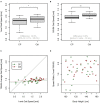Accelerometric Gait Analysis Devices in Children-Will They Accept Them? Results From the AVAPed Study
- PMID: 33585360
- PMCID: PMC7877485
- DOI: 10.3389/fped.2020.574443
Accelerometric Gait Analysis Devices in Children-Will They Accept Them? Results From the AVAPed Study
Abstract
Aims: To assess children's acceptance to wear a 3D-accelerometer which is attached to the waist under real-world conditions, and also to compare gait speed during supervised testing with the non-supervised gait speed in every-day life. Methods: In a controlled observational, cross sectional study thirty subjects with cerebral palsy (CP), with level I&II of the Gross Motor Function Classification System (GMFCS) and 30 healthy control children (Ctrl), aged 3-12 years, were asked to perform a 1-min-walking test (1 mwt) under laboratory conditions, and to wear an accelerometric device for a 1-week wearing home measurement (1 WHM). Acceptance was measured via wearing time, and by a questionnaire in which subjects rated restrictions in their daily living and wearing comfort. In addition, validity of 3D-accelerometric gait speed was checked through gold standard assessment of gait speed with a mobile perambulator. Results: Wearing time amounted to 10.3 (SD 3.4) hours per day, which was comparable between groups (T = 1.10, P = 0.3). Mode for wearing comfort [CP 1, Range (1,4), Ctrl 1, Range (1,6)] and restriction of daily living [CP 1, Range (1,3), Ctrl 1, Range (1,4)] was comparable between groups. Under laboratory conditions, Ctrl walked faster in the 1 mwt than CP (Ctrl 1.72 ± 0.29 m/s, CP 1.48 ± 0.41 m/s, P = 0.018). Similarly, a statistically significant difference was found when comparing real-world walking speed and laboratory walking speed (CP: 1 mwt 1.48 ± 0.41 m/s, 1 WHM 0.89 ± 0.09 m/s, P = 0.012; Ctrl: 1mwt 1.72 ± 0.29, 1 WHM 0.97 ± 0.06, P < 0.001). Conclusion: 3D-accelerometry is well-enough accepted in a pediatric population of patients with CP and a Ctrl group to allow valid assessments. Assessment outside the laboratory environment yields information about real world activity that was not captured by routine clinical tests. This suggests that assessment of habitual activities by wearable devices reflects the functioning of children in their home environment. This novel information constitutes an important goal for rehabilitation medicine. The study is registered at the German Register of Clinical Trials with the title "Acceptance and Validity of 3D Accelerometric Gait Analysis in Pediatric Patients" (AVAPed; DRKS00011919).
Keywords: cerebral palsy; gait speed; laboratory conditions; real-world conditions; wearables.
Copyright © 2021 Wiedmann, Grassi, Duran, Lavrador, Alberg, Daumer, Schoenau and Rittweger.
Conflict of interest statement
MG was employed by Trium Analysis Online GmbH and Sylvia Lawry Centre for Multiple Sclerosis Research e.V. at the time of the study. MD was employed by Trium Analysis Online GmbH. Trium Analysis Online GmbH, Sylvia Lawry Centre for Multiple and MD are owners of trademarks/design/patent/patent applications linked to actibelt technology (detailed list available upon request). The remaining authors declare that the research was conducted in the absence of any commercial or financial relationships that could be construed as a potential conflict of interest.
Figures






References
LinkOut - more resources
Full Text Sources
Other Literature Sources
Miscellaneous

